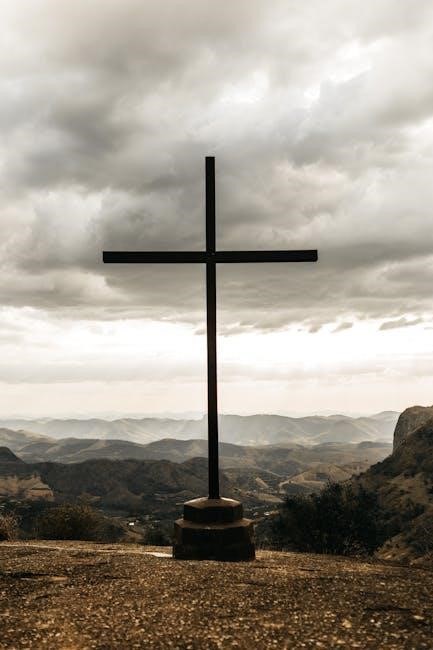The 14 Stations of the Cross are a sacred Catholic devotion, retracing Jesus’ final journey to Calvary. Each station reflects on key events from His condemnation to burial, offering a profound spiritual reflection on His sacrifice and love.
Overview of the Stations of the Cross
The Stations of the Cross are a devotional prayer that consists of 14 distinct stations, each representing a significant event in Jesus’ journey from condemnation to burial. This sacred tradition invites believers to reflect on Christ’s passion and death, fostering a deeper connection to His sacrifice. The stations are often accompanied by prayers, meditations, and Scripture readings, offering a structured way to contemplate the spiritual significance of each moment. Many churches and individuals use visual representations, such as images or icons, to enhance the experience. The devotion is particularly popular during Lent and can be practiced individually or in community, making it a powerful tool for spiritual growth and reflection on the meaning of Christ’s love and redemption.
Historical Significance of the Devotion
The Stations of the Cross hold profound historical significance as a devotion rooted in early Christian pilgrimage. The practice originated in the Holy Land, where believers retraced Jesus’ final steps along the Via Dolorosa. By the 17th century, the devotion spread to Europe, adapted for those unable to visit Jerusalem. The 14 stations were formalized in 1686, reflecting key events from Jesus’ condemnation to burial. This tradition has since become a cornerstone of Catholic spirituality, especially during Lent, offering a tangible way to connect with Christ’s Passion. Its enduring popularity underscores its role in fostering faith and penance, making it a timeless devotion for millions worldwide;
Purpose of the 14 Stations
The 14 Stations of the Cross serve as a spiritual tool to reflect on Christ’s Passion, fostering empathy and gratitude for His sacrifice. Each station invites believers to pause, pray, and meditate on specific moments of Jesus’ journey to Calvary. This devotion encourages followers to connect deeply with His suffering, ultimately deepening their faith and relationship with God. The stations also provide a structured format for prayer and contemplation, helping individuals to walk spiritually alongside Jesus, acknowledging the love and redemption He offered. By engaging with the Stations, believers are reminded of the profound meaning of Christ’s sacrifice, inspiring personal reflection and spiritual growth.
The Stations of the Cross are 14 devotional reflections on key events from Jesus’ condemnation to His burial, with prayers and meditations guiding believers spiritually.
Station 1: Jesus Is Condemned to Death
The first station depicts Pontius Pilate condemning Jesus to death by crucifixion. Despite knowing Jesus’ innocence, Pilate succumbs to the pressures of the crowd, sentencing Him to a brutal execution. This scene reminds us of the destructive power of fear and injustice. Jesus’ silence in the face of false accusations reflects His divine acceptance of God’s will. The station invites believers to reflect on the weight of sin and the sacrifice Jesus willingly undertook for humanity’s redemption. It encourages prayer for the courage to stand against injustice and to embrace humility in the face of adversity. The opening prayer here emphasizes repentance and devotion to Christ’s Passion.
Station 2: Jesus Takes Up His Cross

At the second station, Jesus accepts the cross, symbolizing His willingness to bear the burden of humanity’s sins. This moment reflects His profound obedience to God’s will and His unwavering love for mankind. The cross represents both suffering and redemption, inviting believers to contemplate the weight of their own sins and the sacrifice made for their salvation. In prayer, we ask for the grace to carry our own crosses with patience and faith, following Jesus’ example. This station emphasizes the importance of self-denial and trust in God’s plan, even in the face of adversity. It calls us to reflect on how we, like Jesus, can embrace our struggles for the greater good.
Station 3: Jesus Falls for the First Time
The third station depicts Jesus falling under the weight of the cross, symbolizing His physical and emotional struggle. This moment invites believers to reflect on the consequences of sin and the sacrifices made for redemption. Jesus’ fall reminds us of our own vulnerabilities and the need for humility. In prayer, we ask for the strength to carry our burdens and to rise again after stumbling. This station calls us to contemplate how our sins contributed to Jesus’ suffering and to seek forgiveness. It also encourages us to trust in God’s grace, even when faced with life’s challenges. The fall of Jesus is a powerful reminder of His humanity and divine love. Through this station, we are invited to walk closer with Him, sharing in His sorrow and ultimate triumph.
Station 4: Jesus Meets His Mother
At the fourth station, Jesus encounters His mother, Mary, along the path to Calvary. This heart-wrenching meeting speaks to the deep sorrow and love shared between them. Mary, witnessing her Son’s suffering, embodies the pain of a mother and the faith of a disciple. Jesus, though burdened by the cross, offers her comfort, demonstrating His divine strength and love. This station invites believers to reflect on the role of Mary in Jesus’ life and the Church, as well as the universal experience of a mother’s love and sacrifice. It also calls us to consider how we, like Mary, can stand faithfully with Jesus in times of trial. The encounter reminds us of the transformative power of love and faith in the face of suffering. Through this station, we are invited to deepen our devotion to Mary and to seek her intercession in our lives.
Station 5: Simon of Cyrene Helps Jesus Carry the Cross
At the fifth station, Simon of Cyrene is compelled by Roman soldiers to assist Jesus in carrying the cross. This moment highlights both the physical toll of Jesus’ journey and the intervention of an outsider who becomes entangled in His fate. Simon’s reluctant yet necessary aid symbolizes the shared human experience of bearing burdens, both literal and metaphorical. It also reflects the universal call to assist others in their struggles, mirroring Christian teachings of compassion and service. This station invites reflection on our own willingness to help carry the crosses of those around us, just as Simon was called to support Jesus. Through Simon’s actions, we are reminded of the importance of solidarity and shared responsibility in times of hardship.
Station 6: Veronica Wipes the Face of Jesus
At the sixth station, Veronica, moved by compassion, steps forward to wipe the face of Jesus with a cloth. This act of kindness captures the profound humanity of Jesus’ journey. Veronica’s courage to approach Him amidst the crowd reflects her deep devotion and empathy. The image of Jesus’ face imprinted on the cloth, known as the Veil of Veronica, has become a revered symbol in Catholic tradition, representing both the physical and spiritual suffering of Christ. This station invites reflection on the importance of compassionate acts and the transformative power of faith. It also reminds us to seek God’s face in our own lives, just as Veronica sought to comfort Jesus in His time of need. Through her actions, we are called to embrace humility and selfless love.
Station 7: Jesus Falls for the Second Time
At the seventh station, Jesus falls for the second time under the weight of the cross. This moment underscores the physical and emotional toll of His journey. The second fall intensifies His suffering, exacerbated by the relentless scourging and the crown of thorns. Despite His exhaustion and pain, Jesus perseveres, embodying unwavering commitment to His divine mission. The crowd’s reaction varies—some jeer, while others watch in silence, reflecting the mixed responses to His sacrifice. This station invites us to contemplate the depths of Christ’s endurance and the universal human struggle with sin and weakness. It also calls us to reflect on how our own failings can be transformed through faith and perseverance.
As we meditate on this station, we are reminded of the importance of seeking strength in God during life’s challenges. Jesus’ second fall teaches us to embrace humility and trust in divine providence, even in moments of despair. By uniting our struggles with His, we find the courage to carry our own crosses and grow closer to Him. This station encourages us to pray for the grace to rise again after falling and to remain faithful to our spiritual journey. Let us ask for the strength to walk with Jesus, bearing our burdens with love and hope.
Station 8: Jesus Speaks to the Women of Jerusalem
As Jesus continues His journey, He encounters a group of weeping women from Jerusalem. Despite His own immense suffering, He turns to them with compassion and says, “Do not weep for me, but weep for yourselves and for your children.” This moment highlights Jesus’ concern for the future sorrows of humanity, urging the women to repent and seek spiritual renewal. The women’s tears reflect their sorrow for His fate, yet Jesus redirects their focus to their own need for conversion. This station invites us to reflect on how we, like the women, often mourn external sufferings while neglecting our own spiritual state. It calls us to examine our lives and turn to God with heartfelt repentance. Let us pray for the grace to heed Jesus’ words and embrace a life of true conversion.
Station 9: Jesus Falls for the Third Time

As Jesus stumbles for the third time under the weight of the cross, His physical strength is depleted, and His body bears the intense suffering of the scourging and falls. This moment underscores the humanity of Christ, who, despite being divine, endures immense pain and weakness. The third fall serves as a poignant reminder of the consequences of sin and the depth of God’s love. It invites believers to reflect on their own weaknesses and sins, urging them to seek spiritual conversion; Let us pray for the grace to acknowledge our frailty and to unite our sufferings with Christ’s, trusting in His redemptive power. May this station inspire us to carry our own crosses with faith and perseverance.

Station 10: Jesus Is Stripped of His Garments
At the tenth station, Jesus is stripped of His garments, exposing His vulnerable and wounded body to the jeering crowd. This act of humiliation symbolizes the stripping away of His dignity and the profound sacrifice He endures for humanity’s salvation. The soldiers’ indifference contrasts sharply with the depth of Christ’s love. This moment invites reflection on the ways we, like the crowd, may remain indifferent to the sufferings of others. Let us pray for the grace to recognize the value of humility and to clothe ourselves in compassion and kindness. May this station remind us of the importance of treating all with dignity and respect, as we journey toward a deeper union with Christ.
Station 11: Jesus Is Nailed to the Cross
At the eleventh station, Jesus is nailed to the cross, a brutal act that underscores the extreme suffering He endures for the redemption of humanity. The nails pierce His hands and feet, symbolizing His complete surrender to the Father’s will. This moment is a profound expression of divine love, as Jesus offers His life to atone for the sins of the world. The cross becomes a symbol of salvation, where Christ’s sacrifice transforms suffering into redemption. Let us reflect on the depth of His love and the willingness to endure such pain for our sake. May this station inspire us to embrace our own crosses with faith and trust in God’s plan.
Station 12: Jesus Dies on the Cross
At the twelfth station, Jesus breathes His last on the cross, surrendering His life in fulfillment of God’s plan for humanity’s salvation. As He utters His final words, “It is finished,” He seals the redemption of the world. The death of Jesus is a profound act of love, where He willingly gives His life to atone for the sins of all people. The cross, once a symbol of suffering, becomes a symbol of triumph and salvation. In this moment, Christ’s divine love reaches its pinnacle, offering humanity the gift of eternal life. Let us reflect on the depth of His sacrifice and the boundless mercy He extends to us. May His death inspire us to live in gratitude and devotion to His love.
Station 13: Jesus Is Taken Down from the Cross
At the thirteenth station, Joseph of Arimathea and Nicodemus lovingly remove Jesus’ lifeless body from the cross, fulfilling ancient prophecies. This poignant moment reflects the profound sorrow of those who loved Him, especially His mother Mary. The act of taking Jesus down from the cross symbolizes the end of His earthly suffering and the preparation for His burial. It invites us to contemplate the depth of Christ’s sacrifice and the compassion of those who reverently cared for His body. This station also reminds us of the Church’s devotion to the deceased and the dignity of the human body. Let us reflect on the love and care shown to Jesus, even in death, and strive to emulate such compassion in our lives.
Station 14: Jesus Is Buried
The final station, Jesus is buried, marks the culmination of His earthly journey. After being taken down from the cross, His body is reverently placed in a tomb by Joseph of Arimathea and Nicodemus. This act of love and devotion signifies the end of His physical suffering and the completion of His sacrifice for humanity. The burial of Jesus is a moment of profound sorrow and reverence, inviting us to reflect on the depth of His love and the sacrifice He made for our redemption. It also serves as a reminder of the hope of resurrection, as the tomb would soon become a place of triumph. Let us pray for the grace to embrace the mystery of death and resurrection in our own lives.

Prayers and Meditations
Prayers and meditations guide believers through the Stations of the Cross, fostering reflection on Christ’s Passion. Opening prayers set the tone, while specific prayers for each station deepen devotion, inviting spiritual growth and unity with Christ’s sacrifice.
Opening Prayer for the Stations of the Cross
The opening prayer initiates the devotion, inviting participants to walk spiritually with Jesus. It expresses sorrow for sins and seeks grace to follow Him faithfully. The prayer is a heartfelt plea for mercy and strength, aligning the believer’s intentions with Christ’s redemptive journey. This prayer sets a contemplative tone, encouraging reflection on the divine love demonstrated through His Passion.
Prayers for Each Station
Specific prayers accompany each of the 14 Stations, deepening reflection on Jesus’ Passion. These prayers, often led by a leader or priest, include responses from participants, fostering communal devotion. Each station’s prayer connects to its event, such as the first fall or meeting Mary. The prayers express sorrow for sins and gratitude for Christ’s redemption. Many begin with “We adore you, O Christ,” followed by reflections on His suffering and its meaning. Participants are encouraged to seek forgiveness and unite their struggles with Christ’s. These prayers guide believers to contemplate the spiritual significance of each station, fostering a deeper connection to Christ’s sacrificial love and its impact on humanity. They are integral to the devotion, enhancing the meditative experience;
Meditations on the Passion of Christ
Meditations on the Passion of Christ are moments of reflection that invite believers to contemplate the depth of Jesus’ love and sacrifice. Each station offers a unique opportunity to engage with the emotional and spiritual dimensions of His journey. Through meditation, participants can reflect on the physical and spiritual suffering Christ endured, fostering a deeper connection to His divine love. These meditations often include scriptural passages, prayers, and personal reflections, encouraging believers to seek forgiveness and renewed commitment to their faith. The meditations also emphasize gratitude for the redemption won through Christ’s Passion. Many resources, including PDF guides, provide structured meditations to help believers fully immerse themselves in the spiritual journey of the Stations of the Cross.

Downloading the 14 Stations of the Cross PDF
The 14 Stations of the Cross PDF is widely available for download, offering prayers, meditations, and reflections. It includes scriptural readings and devotional guides, perfect for personal or communal use, and can be easily accessed from various religious websites or apps.
Where to Find the PDF

The 14 Stations of the Cross PDF can be easily found on various religious websites, Catholic church portals, and devotional platforms. Many official church websites offer free downloads, often accompanied by prayers, meditations, and reflections. Religious apps and online repositories also provide accessible links to download the PDF. Additionally, some Catholic organizations and publishers offer downloadable booklets that include the Stations of the Cross with images, Scriptures, and prayers. These resources are designed to facilitate personal or communal devotion, making it convenient for individuals to deepen their spiritual reflection during Lent or any time of the year.
How to Use the PDF for Devotion
Using the Stations of the Cross PDF for devotion involves a reflective journey through each station, pausing to pray, read Scriptures, and contemplate the significance of Christ’s passion. Begin with an opening prayer, expressing contrition and inviting God’s grace. At each station, recite the designated prayers and meditate on the accompanying reflections, allowing the spirit of penance to guide your heart. The PDF often includes images and biblical references, enhancing the devotional experience. Walking through the stations, either physically or spiritually, mirrors Christ’s path to Calvary, fostering a deeper connection to His sacrifice. Conclude with a closing prayer, giving thanks and seeking strength to apply the lessons of the Cross in daily life, fostering personal growth and spiritual renewal.
Additional Resources for Reflection

Beyond the PDF, numerous resources enhance the Stations of the Cross experience. Prayer booklets with Scriptures and meditations, such as those by St. Alphonsus Liguori, offer deeper insights. Audio recordings provide guided reflections, perfect for personal or group devotion. Visual aids like high-quality images or videos complement the PDF, enriching contemplation. Many websites offer downloadable Stations of the Cross guides tailored for children or specific spiritual focuses. Additionally, mobile apps allow for on-the-go reflection, featuring prayers, Scriptures, and customizable meditations. These resources collectively provide a holistic approach to engaging with Christ’s passion, fostering a more meaningful and personal connection to the Stations.
The Stations of the Cross offer a profound spiritual journey, inviting reflection on Christ’s sacrifice and its relevance to daily life. May this devotion deepen your faith and inspire compassion, humility, and love, guiding you to walk in His footsteps.
The Spiritual Significance of the Stations
The Stations of the Cross hold profound spiritual significance, inviting believers to reflect on Christ’s Passion and death. By meditating on each station, individuals deepen their connection to His sacrifice, fostering empathy, gratitude, and repentance. The devotion encourages a personal encounter with Christ’s love, highlighting the redemptive power of His suffering. It also reminds us of the universal call to carry our own crosses with faith and courage. Through this sacred journey, believers are inspired to embrace humility, compassion, and forgiveness, drawing strength from Christ’s example. The Stations of the Cross are not just a historical remembrance but a transformative spiritual practice that nurtures a deeper relationship with God and His divine plan of salvation.
Applying the Lessons of the Cross in Daily Life
The Stations of the Cross offer timeless lessons for everyday living, encouraging believers to embrace Christ-like virtues. Reflecting on His perseverance, humility, and forgiveness, we are called to face life’s challenges with courage and grace. Each station invites us to grow in selflessness, compassion, and trust in God’s plan. By meditating on Christ’s journey, we learn to carry our own crosses with patience and faith, transforming struggles into opportunities for spiritual growth. The Stations remind us to forgive others, as Christ forgave, and to love unconditionally, even in adversity. Integrating these lessons into daily life fosters a deeper connection with God and inspires us to live with purpose, hope, and resilience.